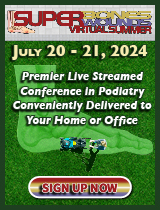





|

|
|
|

|
Search
05/24/2022 Allen Jacobs, DPM
OTC Topical Nail Antifungals vs. Prescription Products (Elliot Udell, DPM)
People seek care for, and in most circumstances
may be treated for, onychomycosis. In some
populations, such as patients with diabetes, PAD,
chronic edema, immunosuppressive, onychomycosis is
associated with increased incidence of repeated
cellulitis, ulceration, and other significant poor
outcomes. We have known this ever since the
classic study of Jeffrey Robbins, DPM.
The use of ineffective therapies denies patients
who should be treated, or who desire treatment, of
effective treatment.
Here is my approach to onychomycosis;
1. Read and consider following the guidelines of
the American and/or British dermatology
associations.
2. Speciation testing to verify fungal infection
and the pathogen. Itraconazole, fluconazole, may
be more appropriate in some patients. Some
patients may not have presumptive onychomycosis.
As Ronald Reagan said, “ trust (your judgment) but
verify ( it is fungal and fungal alone ).
3. Perform PAS or other appropriate studies for
the presence of repetitive micro-trauma. This is
commonly a cormorbid condition increasing
therapeutic failure rates. In some patients, a
tenotomy or arthroplasty or arthrodesis is needed
to affect a cure.
4. Read the studies you are told support the use
of topical antifungal therapy. Pay particular
attention to inclusion criteria and total cures
(mycological and clinical appearance). If you do
do, you will restrict the isolated use of topicals
to those with less than 50% of nail plate disease
(i.e.: early distal disease).
5. Statistical protection is not absolute
protection. When providing systemic therapy,
obtain baseline laboratory studies and monitor at
least initially.
6. Consider topicals as adjunctive to systemic
therapy. Or possibly to lower the incidence of
recurrence following cure (theoretical).
7. Consider concurrent treatment of interdigital
or pedal tinea pedis when present. Also reduction
of repetitive trauma. Also consider treatment of
other confounding factors ( eg: hyperhidrodis,
xerosis, shoe/sock materials, edema reduction ).
Step back and take a global view.
8. Get over terbinaphobia. This includes diabetic
patients and geriatric patients. Read the relevant
studies. They are supportive of use.
9. Educate your patients on the realities of
onychomycosis. Remember, you may bill for time
including time of consultation if that is what it
takes to have you do so.
11. If you are prescribing a costly topical
therapy, confirmation, speciation, r/o repetitive
micro-trauma to justify the thousands of dollars
these topicals cost.
12. Read and research on the subject. Do not
simply take the word of paid consultants and
lecturers on ANY subject. And that includes
onychomycosis just the same as bunion surgery or
PTTD surgery.
13. Remember, to the patient who has come to you
for this problem, it is not a minor or
insignificant issue. They are in your office
requesting direction and effective treatment. As
such they deserve nothing less.
Allen Jacobs, DPM, St. Louis, MO
Other messages in this thread:
05/20/2022 Charles Morelli, DPM
OTC Topical Nail Antifungals vs. Prescription Products (Elliot Udell, DPM)
Dr. Udell asks the question "which products are
most effective, the OTC products or the ones that
require a prescription?". My answer is
unequivocally, neither of them, and I am sure
there are many of you who disagree. That's fine.
After 32 years of practice, and with the exception
of those few patients who presents with
superficial white onychomycosis, I never see
topicals being an effective treatment for the
types of severe fungal nails that we see on a
daily basis. Certainly not infections that
permeate the nail plate, and go deep into the nail
bed.
My treatment of choice for almost 100% of patients
who want to get rid of their fungal toenails is
oral terbinafine. It is the gold standard for
onychomycosis and has been for years and after
prescribing for 3 decades, it has been proven to
be quite safe and effective. I vary between 90 day
dosing or pulse dosing for either one or two
years, depending on the patient's response. And
even patients who are afraid to take terbinafine
based on what they read on Dr. Google, will then
agree to pulse dosing as it is fewer pills and a
safer option in their minds.
At times, I will prescribe a topical after oral
terbinafine as a preventative going forward, but
for patient whose nails grow slowly and still have
a substantial amount of fungus presents after 90
days, I will give them a year of pulse dosing (7
pills every 3 months) and they get better. Then
prescribe a topical as a preventative
One of the main reasons why topicals are fair to
poor at best is due to patient compliance. Its
almost impossible to get a patient to agree to
apply a topical to their nails either once or
twice a day, depending on the product you've
chosen. It gets old very fast. Once they
understand that they are more than happy to take
terbinafine.
Take an appropriate history, rule out hepatic
disease, check their last blood test and do
another after therapy has been completed if it
puts your mind at ease. As Google will tell you
acetaminophen overdose is the leading cause for
calls to Poison Control Centers (>100,000/year)
and accounts for more than 56,000 emergency room
visits, 2,600 hospitalizations, and an estimated
458 deaths due to acute liver failure each year.""
I have never had an adverse reaction to
terbinafine because I monitor my patients, and if
and when that should happen, stop the medication
and the patient will be fine in a few days.
Charles Morelli, DPM, Mamaroneck, NY
|
| |

|
|
|







